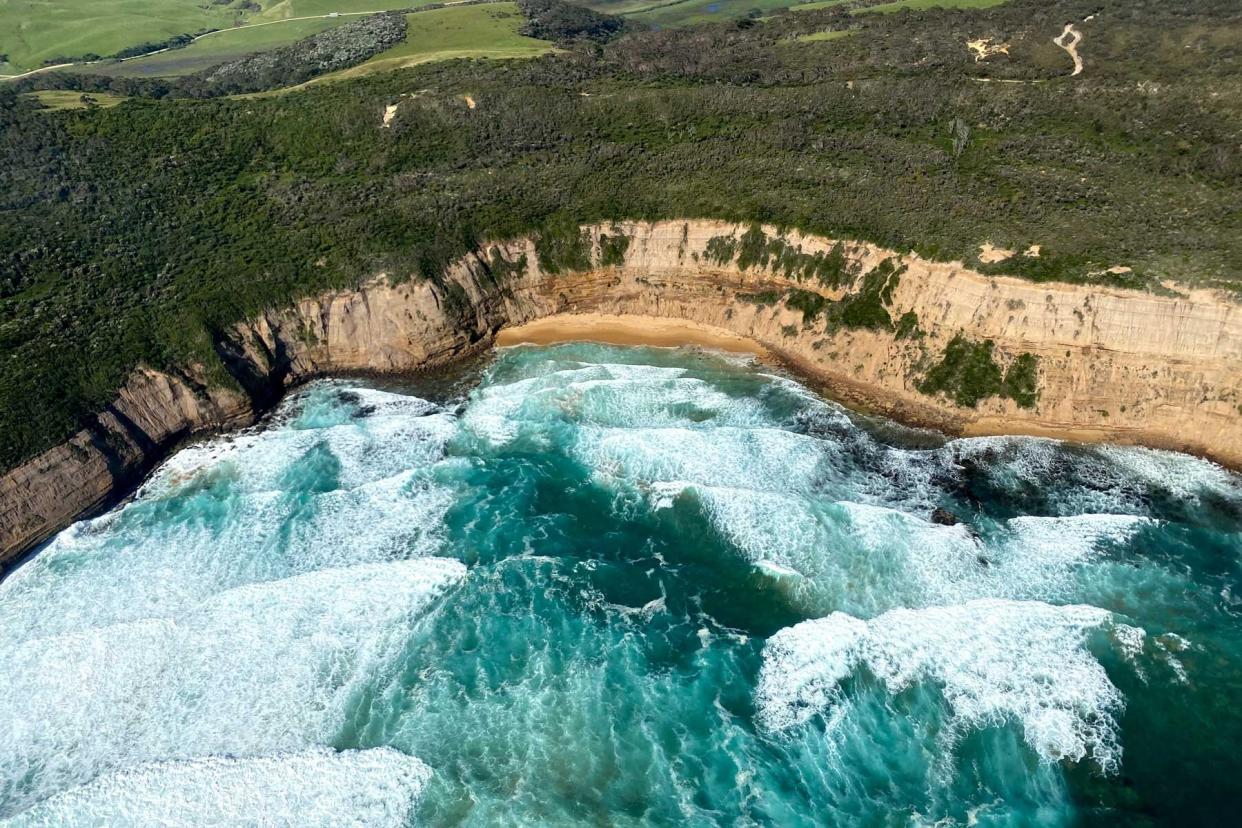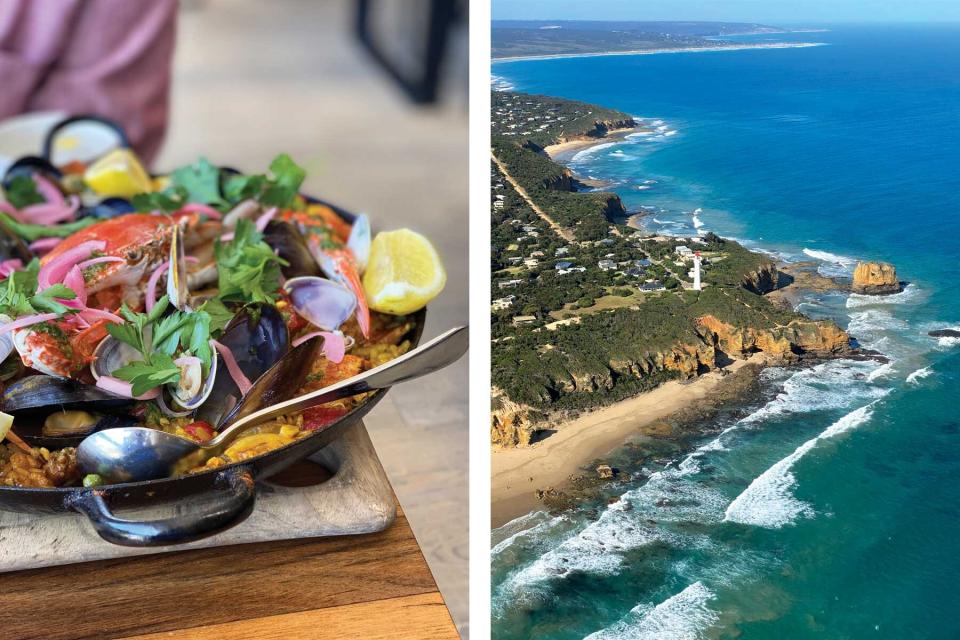Why Driving the Great Ocean Road Is The Trip I’ve Dreamed About Most During COVID

Sarah Bruning
Since COVID-19 put the world on lockdown last year, I've spent most of my time grounded at home. In the absence of far-flung vacations, I've spent countless hours getting lost in my favorite travel memories, like savoring pintxos in San Sebastian, zipping along a glacier lagoon in a zodiac in southern Iceland, and clambering through narrow passageways inside the Great Pyramid of Giza. But the trip I've fantasized about most often is the last big vacation I took before borders closed: a week-long Australian adventure in November of 2019.
A few months prior, my husband had come across two first-class miles tickets from New York to Melbourne. After much debate, we decided to split our time between the cosmopolitan capital of Victoria and the island state of Tasmania, which sits about an hour south via plane. Squeezing two destinations into the itinerary required serious strategizing if we didn't want to run ourselves ragged. So while I'd already amassed a litany of restaurants, bars, and wineries, I fought the urge to start with those reservations and prioritized the big ticket event: the Great Ocean Road. An Australian National Heritage site, the roughly 150-mile stretch of highway winds its way along Australia's scenic southern coast, from the beach towns of Torquay to Allansford.
With only three full days in and around Melbourne, we immediately ruled out doing the whole route since that would take five hours each way (without stops). But even getting to the iconic 12 Apostles rock formation would only shave off an hour each way, and I didn't want to be the one behind the wheel for any of it. I've long nursed a driving phobia — my parents had to bribe me to get my license in high school — so the thought of racing down the opposite side of the road at highway speeds sent my anxiety through the roof. But if my husband were forced to drive the whole time, he'd hardly get to enjoy any of the magnificent scenery we'd come so far to see.
Fortunately, I had a solution. At a conference in 2018, I'd met Stuart Dobson and Paul Murray, a pair of genial Aussie natives who run Acacia Luxury Private Tours. The Melbourne-based duo offer both set and bespoke itineraries that deliver big on the region's highlights, including the Great Ocean Road. Perusing the options on the company's site, I noticed a one-day combination car-and-helicopter trip that would not only make the most of our time, but provide two different vantage points from which to see the rugged coastline. Totally worth the splurge, I justified.
At 8 a.m., Stuart picked us up from our hotel, the hip QT Melbourne, in a cushy Audi SUV. As we made our way out of the Central Business District, he outlined the day and filled us in on the Great Ocean Road's history. The infrastructure project began in 1919 as a means of employing soldiers who'd just returned home from World War I. "That post-war period has always been a very pivotal time in our country's young history," he explained. "It was really our coming of age." Construction took 13 years as builders were mostly using crude equipment like picks, shovels, and carts; a small amount of dynamite was available, but it was used sparingly as detonations still triggered PTSD in some of the just-returned soldiers. Once complete, the road opened up and connected several coastal towns that had previously only been accessible by water.
About 90 minutes in, we caught our first sweeping Surf Coast views at Bells Beach. While we didn't spot anyone actually in the water that morning, looking out over the shrub-covered bluffs, I could see why the steady waves would attract pro and amateur surfers from around the world. Twenty minutes later, we paused for flat whites and scones at the Lighthouse Tea Rooms on the Aireys Inlet, where the nearby Split Point Lookout offered another stunning view. With its cerulean waters, craggy cliffs, and wind-hardened plants, the shoreline reminded me of the Central California coast I spent many summers exploring as a kid, but seen through the lens of a saturated Instagram filter.
"It's just unreal," I remarked as our trio made its way back to the car. "Just wait," said Stuart as he hopped back behind the wheel. "Between the townships of Lorne and Apollo Bay, the road traces the coast and is often carved into the side of a cliff. It's relentlessly beautiful."
As we passed under the iconic Memorial Arch, I mentioned we hadn't yet had the opportunity to see any of the native wildlife on our trip, so Stuart asked if we'd be interested in stopping by a local campground frequented by wild koalas and a few types of native birds. Sure enough, shortly after we pulled off the road, we came across a low-hanging tree packed with scarlet-and-purple rosellas, bright white cockatoos, and Christmas-colored parrots, one of which perched on Stuart's arm the second he revealed a handful of seeds. Leaving the birds, we ambled up a dirt path, our eyes scanning the towering eucalyptus trees for koalas. Sure enough, after a few minutes, I felt a gentle smack on my shoulder as my husband spotted a tiny ball of fur snoozing in the crook of a high branch. With only my short lens in tow, I resisted the urge to bust out my DSLR and instead contented myself with quiet observation — something that had never come naturally to me, but that I've now come to appreciate over the course of the pandemic.

Sarah Bruning
After a divine paella and seafood lunch at La Bimba in Apollo Bay, we picked up the pace, passing through the eucalypt forests of Great Otway National Park on our way to the Shipwreck Coast. As we cruised, Stuart previewed our next stop: the Razorback at Loch Ard Gorge. "It's one of my favorite vistas," he said. "It's a towering slither of limestone surrounded by other dramatically shaped outcrops. Less visited, but every bit as stunning as the Twelve Apostles, especially on a day when the swells of the Southern Ocean are in full force."
Standing cliffside — eyes flitting back and forth between the formation and the seemingly endless ocean — my thoughts kept circling around time. It had taken millennia, and the steady forces of nature, to carve the narrow strip of rock from the rest of the terrain to reveal the layers of earth I was seeing today. We quickly dipped down to the gorge, named for one of the wrecked clipper ships that give this section of the Victoria coast its name, to wiggle our toes in the sand and get a closer look at the limestone strata before the final stop of the day.
While we backtracked to the Twelve Apostles, Stuart dropped a truth bomb: "Funny thing is, there were never actually 12." Turns out, only eight stacks had ever actually existed — like the Razorback, a result of relentless waves eroding the land to form caves that eventually gave way. The revelation didn't make seeing the iconic pillars, juxtaposed against the fawn-colored sand and aquamarine water, any less thrilling. It was another moment where I was torn between trying to capture the perfect photo (or at least a half-decent one) and just basking in the golden afternoon light and breathing in the crisp ocean air.
But the best views of the day were yet to come. Stuart bid us farewell at the 12 Apostles helipad, where my husband and I climbed into a cherry-red copter for the 75-minute scenic flight back to Melbourne. Between the time we lifted off and the time we touched down back in the city, my forehead was pretty much glued to the window. Flying at about 1,000 feet, we could fully appreciate the details of the terrain we'd just seen up close, but with the added bonus of taking in the broader scene. The bird's-eye view amplified the jaggedness of the cliffs, the turquoise of the waves, and the frothy white of the sea spray.

Sarah Bruning
Before I knew it, the towering skyline of Melbourne appeared on the horizon. After we touched down at a riverside helipad, Paul picked us up to take us back to the QT. When he asked how we'd liked the adventure, my husband and I turned to each other with giddy smiles and laughed. In the moment, a gobsmacked "It was unreal!" was the best I could muster.
Now that I've had some time to fully absorb the experience — and repeatedly flick through the hundreds of photos I took — I can safely say it was one of the best travel experiences I've ever splurged on. Not only did we get to spend extended quality time with a local, who could share his favorite off-the-beaten-path spots along one of Australia's busiest tourist attractions, but it was a chance to appreciate the incredible scenery from an unexpected (and unforgettable) vantage point.

